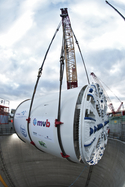Lee Tunnel cutterhead lowered
15 December 2011The cutterhead 8.5m-diameter Lee Tunnel TBM was today lowered down London’s deepest shaft in preparation for the four-mile (6.44km) drive. The GBP 635M (USD 982M) sewer tunnel, part of the larger Thames Tideway project, will prevent 16Mt of sewage entering the River Lee annually.
Tunnelling on the Lee project will encounter high groundwater pressures and abrasive ground on the route from Beckton to Abbey Mills.
Chief executive of client Thames Water, Martin Baggs, said, “The Lee Tunnel will tackle discharges from the largest overflow at Abbey Mills in Stratford, which accounts for 40 per cent of the total discharge. That's why we're dealing with this, the worst one, first.
“The Lee Tunnel is the first of two tunnels, which will collectively capture an average of 39 million tonnes a year of sewage from London's 35 most polluting combined sewer overflows.”
The second tunnel, the ‘Thames Tunnel’, has faced fierce opposition from local residents objecting to construction sites and increased bill costs.
Thames Water’s Lee Tunnel project manager, Roger Mitchell, added, “Lowering the cutter head is a four-hour operation, requiring a lot of precision. We will drive the tunnelling machine through chalk for most of its length.
“Chalk is a weak rock, and easy to excavate by machine, but the biggest challenge is that the chalk contains many flints - a very hard and abrasive rock, lumps of which can vary in size from that of a melon to a car, and we could encounter them anywhere.”
The contractor, a JV of Morgan Sindall, Vinci and Bachy Soletanche began work in September 2010 to build the 80m-deep shaft at Beckton. Tunnelling should begin in January 2012 and is expected to progress at 17m per day. Work will finish in late 2013.
The shield is lowered at the Beckton shaft

